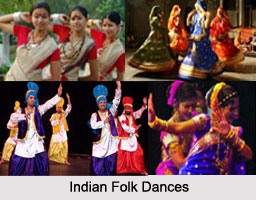 Origin of Indian folk dances forms can be traced to diverse parts of the country. Each form of dance signifies the culture and traditions of a particular area or a group of people. Most of the Indian dances explain and describe the Indian art of livelihood. Indian folk dances are filled with difference and multiplicity in terms of themes, forms, and styles. Folk dances continue to be a different category that can be characterized by the overwhelming naturalness of participation without a false barrier between the actors, performers and in various the audiences.
Origin of Indian folk dances forms can be traced to diverse parts of the country. Each form of dance signifies the culture and traditions of a particular area or a group of people. Most of the Indian dances explain and describe the Indian art of livelihood. Indian folk dances are filled with difference and multiplicity in terms of themes, forms, and styles. Folk dances continue to be a different category that can be characterized by the overwhelming naturalness of participation without a false barrier between the actors, performers and in various the audiences.
Folk dances play a significant role and offer the best focus to express the feelings and emotions to common man. Indian folk dances are roughly classified as per the States boundaries.
Origin of Indian Folk Dances
In many cultures, the term cultural dance or traditional dance is used to specify Folk dances. All folk dances are cultural ones. Not all-cultural dances are folk ones. Folk dances can be categorized into two categories: folk and tribal. The dissimilarity between the two is of cultural. The tribal dances are dances by India`s indigenous populations. These people, identified as adivasi, have customs, which is very diverse from the larger Indian inhabitants. India is the land of great cultural inheritance with its vast diversity of races and conditions has been an absolute fortune house of dance forms for innumerable centuries. It has given confinement to varied forms of dancing, all shaped by the influences of an exacting period and environment.
The Indian folk dance is an original work with the arty steps and postures being accompanied by the lyrical movements of singing or active music. The Indian folk dance has an age old custom and is easy without being inexperienced. In folk tradition, dance is nourishment to the daily life of the people. Every folk dance depicts some appearance of life and meaning. Its depth of beginning and an openness of expression are of immense artistic value.
The idea of representing sentiment in a folk dance is usual and innovative. More than the grace of the character dancer or the talent of the remote style, the total outcome of the overpowering cheerfulness of will, and the expressive, effortless ease with which it is expressed are important.
The Indian folk dance is chiefly performed to convey happiness. It has its own roots, moorings, sustenance, growth, flowering and old age. It has yielded generation after generation of performers. People used to learn dances from parents or grandparents whose lives have been immobile really influenced by customs and traditions and who mastered dancing folk dances straight from their parents in outdoor country parties. Much of what represents the Indian folk, tribal and ritual dance tradition has a close association with the functions of daily life. The peasant community of village India is responsible for creating the folk dances, ritualistic, farming and drifting. Therefore folk dance involves the common people, both inhabiting in the town and the rural areas, and it is a general man`s art.



















